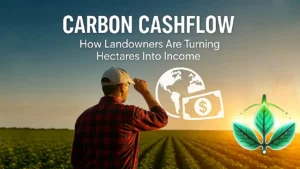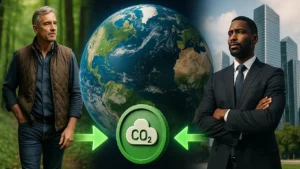
Carbon Cashflow: How Landowners Are Turning Hectares Into High-Yield Income
Across the globe, landowners stand at a critical intersection: how to care for their land while securing a steady, sustainable income. With rising costs, unpredictable climate events, and increased pressure to produce, the traditional ways of making a living from the land are no longer enough.
Carbon credit programs for landowners are flipping the script—offering an exciting, real-world solution that rewards stewardship. Through these programs, landowners can earn thousands of dollars annually for protecting forests, restoring degraded lands, or improving soil health. Even better? With platforms like CO2NEX and its Brazilian partner projects, you can start with zero upfront fees.
Let the planet pay you back. You’re already doing the work—now it’s time to get paid for it.
Stat Spotlight: In 2023, the average price per carbon credit rose to $13.97 in voluntary markets (Ecosystem Marketplace), with some nature-based projects earning $20–$40/credit depending on region and methodology. Just 100 hectares of reforested land can yield $25,000–$50,000/year in credit revenue.
Section 1: Understanding Carbon Credit Programs for Landowners
What Are Carbon Credits—And Why Should You Care?
A carbon credit is a certificate representing the removal or avoidance of one metric ton of CO₂ or its equivalent from the atmosphere. For landowners, this means you can turn carbon sequestration into a commodity—something that companies and governments are actively purchasing to offset their emissions.
And here’s the kicker: You don’t need to plant a forest overnight. You just need the right support to turn your land’s natural processes—trees growing, soil restoring, ecosystems thriving—into verified income.
How Landowners Generate Carbon Credits
Your land already has value—but with carbon credits, it becomes a renewable asset. Here’s how:
- Reforestation & Afforestation: Planting trees on degraded or deforested land. Even a few hectares can earn credits annually.
- Avoided Deforestation (REDD+): If you’re protecting native forest from clearing or logging, that carbon you keep locked in the biomass is valuable—and quantifiable.
- Soil Carbon Sequestration:Through regenerative agriculture and no-till farming, you can build organic matter in soil, pulling CO₂ from the air and storing it underground.
- Agroforestry:Combining agriculture with tree systems increases biodiversity, soil moisture, and—yes—carbon storage.
Example: A landowner in Mato Grosso, Brazil, partnered with a local reforestation NGO and generated over $240,000 USD in carbon credit revenue over three years from reforesting 80 hectares, with zero upfront cost thanks to partner facilitation.
Why Most Landowners Haven’t Tapped In (Yet)
Many landowners miss out simply because of complexity, cost, or lack of access. That’s exactly what platforms like CO2NEX are solving. Through partnerships in Brazil, Africa and beyond, CO2NEX offers:
- No upfront fees for landowners
- Transparent, verified carbon accounting
- Support for project setup and documentation
- Access to a global carbon buyer marketplace
Section 2: Carbon Credit Programs for Landowners – The Financial Payoff Is Real
For most landowners, the big question is simple: How much money can I actually make—and is it worth the effort?
The answer? Absolutely.
Carbon credit programs are no longer just for government agencies or big NGOs. Today, private landowners are earning real income—often in the tens of thousands of dollars per year—just for keeping their forests standing, their soil healthy, or their pastures sustainably managed.

Real-World Earnings: Dollars for Every Tonne of Carbon
Here’s what’s already happening:
- Forest Concessions Bill in Brazil:
Approved by Brazil’s Congress, this legislation is expected to generate over $24 million USD annually in carbon credit revenue for private companies managing forest areas (Reuters).
- Land Use Economics Shift at $10/ton:
Studies show that when carbon credit prices hit just $10 per metric ton, forest conservation becomes more profitable than cattle ranching in much of Brazil. That’s a massive economic turning point (World Bank Carbon Pricing Dashboard). - State-Level Carbon Wealth in Tocantins:
Tocantins is preparing to distribute more than
$430 million USD in carbon credit revenue by 2030, rewarding landowners who preserve native forests (Agência Brasil).
- Zero-Cost Access with CO2NEX:
Through
CO2NEX’s verified program, landowners in the Amazon and Cerrado biomes can enroll with zero upfront investment—and start earning once the carbon is verified.
Stat Spotlight: In Brazil’s Amazon biome, carbon projects on restored or preserved rainforest land average $100–$300/hectare/year, while in the Cerrado biome, savanna restoration can yield $40–$120/hectare/year, depending on carbon density and methodology (Imazon, EM Marketplace).
Section 3: How to Register for a Carbon Credit Program – Step-by-Step for Landowners
You don’t need to be a scientist or a government official to tap into the carbon credit market. With the right support, you can turn your land into a verified climate asset.
Here’s exactly how it works:
Step-by-Step Carbon Credit Registration Process
- Land Assessment
An expert evaluates your land’s carbon potential—measuring forest density, soil condition, and biodiversity.
- Project Design
A detailed plan is drafted outlining the practices (like reforestation or avoided deforestation) you’ll implement to generate credits. - Validation
An accredited third party reviews your project to ensure it meets international carbon standards (like Verra, Gold Standard, etc.).
- Registration
Your project is registered with a recognized carbon registry, giving it legitimacy and tradability.
- Monitoring
You’ll track the environmental impact of your practices over time, usually with support from your project partner.
- Verification
Regular audits by independent verifiers confirm that the emission reductions are real and measurable.
- Issuance
Verified carbon credits are officially issued and appear in your registry account—ready for sale.
- Sale
Credits are sold on the voluntary or compliance carbon markets, depending on your location and buyers’ needs.
CO2NEX: Your Carbon Credit Concierge
CO2NEX’s mission is to make carbon markets accessible and profitable for everyday landowners—without the headache or hidden costs. Here’s how they help:
- Zero Upfront Fees: CO2NEX partners with Brazil-based coordinators to cover registration and monitoring costs, so landowners don’t pay anything until revenue is generated.
- Full-Service Project Management: From satellite GIS imagery teamed with AI, to regulatory paperwork, CO2NEX helps every step of the way.
Direct Market Access: CO2NEX connects you to buyers on the international voluntary market, ensuring you get fair prices and real cash flow.
Section 4: The Top 5 Mistakes Landowners Make (and How to Avoid Them)
Entering the carbon credit world can be life-changing—but only if it’s done right. Many landowners unknowingly leave thousands of dollars on the table or stall their projects before they even start. Here are the most common (and costly) mistakes to avoid:
1. Waiting Too Long to Get Started
The mistake: Landowners delay getting their property assessed or wait until they’ve “cleaned it up,” thinking there will be a better time later.
The fix: Carbon credit eligibility is based on historical baselines. That means the longer you wait, the fewer credits you may qualify for—especially in areas under development pressure.
Pro tip: Even degraded or partially used land can qualify if it shows restoration potential. The best time to get assessed is now.
2. Paying Upfront Fees to the Wrong Partner
The mistake: Signing contracts with platforms or brokers that charge thousands in project design, validation, or registration fees—before credits are even earned.
The fix: Use platforms like CO2NEX, which charges no upfront fees and only gets paid when you get paid. This reduces risk and aligns everyone’s incentives.
3. Choosing the Wrong Carbon Standard
The mistake: Registering under low-credibility or outdated standards that don’t hold value in today’s markets.
The fix: CO2NEX works only with globally recognized standards like Verra (VCS) and Gold Standard, which ensure credibility, transparency, and higher resale value for your credits.
4. Ignoring Verification Requirements
The mistake: Underestimating the importance of ongoing monitoring and third-party verification, which is critical for credit issuance.
The fix: Don’t go it alone. CO2NEX coordinates professional monitoring, satellite AI assessments, and annual reports so your project stays compliant and profitable.
5. Failing to Understand Market Timing
The mistake: Selling all their credits too quickly or during a market dip, instead of watching trends or diversifying buyers.
The fix: CO2NEX provides market insights to help landowners time their credit sales and even negotiate with corporate buyers, maximizing income over time.

Ready to Start Earning from Your Land?
If you own land, you’re already sitting on untapped income. Every hectare can generate real, recurring revenue—without clearing a single tree or paying upfront fees.
CO2NEX is currently helping landowners around the world turn reforestation, soil restoration, and forest preservation into a steady stream of income through top-tier carbon credit programs.
It takes just a few minutes to begin.
Fill out CO2NEX’s quick and secure online form to get your FREE land assesment today:
Start Here – CO2NEX Landowner Form
You’ll be partnered with local experts, zero upfront costs, and real-time project support—all designed to make the process as smooth and profitable as possible.
Section 5: Choosing the Right Carbon Credit Program
Not all carbon credit programs are created equal—and for landowners looking to maximize income with minimum risk, choosing the right partner is critical. Here’s what to consider:
Key Factors for Landowners
- Certification Standards: Look for programs that issue credits under internationally recognized systems like Verra or Gold Standard. These ensure your credits are trusted and tradable.
- Market Access: Access to both voluntary and compliance markets means higher demand—and often higher prices—for your credits.
- Support Services: From soil testing, to AI GIS satellite monitoring, a good program offers technical and admin support at every stage.
- Financial Terms: Review the revenue share. Beware of hidden fees or programs that require upfront payments for registration or validation.
Why CO2NEX is a Leader for Landowners
- Zero Upfront Fees: CO2NEX partners with vetted Brazilian coordinators and international networks that eliminate upfront costs to landowners.
- Total Transparency: You see exactly what percentage of credit revenue you’ll earn—no fine print, no surprises.
- Expert Support: CO2NEX helps from the very beginning, walking you through land assessment, documentation, registration, and monetization.
- Global and Local Reach: Whether you’re in the Amazon, Cerrado, or anywhere in the world—CO2NEX has local project managers ready to support you.
Section 6: Environmental and Community Impact
While the income is powerful, the ripple effect of carbon projects reaches far beyond your land’s boundary lines.
Real-World Benefits of Carbon Projects
- Biodiversity Protection: Avoided deforestation preserves native flora and fauna—many of which are endangered or exclusive to your region.
- Soil Regeneration: Practices like agroforestry and no-till farming rebuild soil structure, boost crop yields, and increase long-term land value.
- Water Security: Reforested land filters and retains water, reducing drought risk and improving watershed health.
- Community Growth: Many projects create sustainable jobs, educational outreach, and new revenue streams for local communities.
Participating in a carbon credit program means you’re not only securing your land’s financial future—you’re also contributing to the global mission to reverse climate change, restore ecosystems, and uplift your region.
Conclusion: Turn Your Land into Legacy
The world is changing—and landowners are no longer just caretakers of land. You’re now key players in a global economy built on sustainability.
Through carbon credit programs, landowners can turn conservation into income, trees into currency, and hectares into hope—for themselves, their families, and future generations.
With CO2NEX, the process is transparent, expert-led, and most importantly—free to start.
Take the first step today.
Fill out the CO2NEX Landowner Form and discover how your land can become a source of both financial independence and environmental impact.
The opportunity is real. The time is now. The next move is yours. Contact us Today!
Frequently Asked Questions (FAQ)
1. What are carbon credit programs for landowners?
Carbon credit programs allow landowners to earn income by implementing sustainable land practices that remove or reduce carbon emissions. These practices—like reforestation, agroforestry, or preserving natural vegetation—generate carbon credits that can be sold in global carbon markets. It’s a way to profit from land stewardship without having to sell or exploit your land.
2. How much money can landowners really make from carbon credits?
Income varies by biome, project type, and market prices, but in Brazil for example, savanna and wooded land in the Amazon and Cerrado biomes can earn between $25 to $100+ per hectare annually. Some large-scale landowners in forested areas have seen six-figure revenues per year, especially as carbon credit prices continue to rise globally.
3. What upfront costs are involved in joining a carbon credit program?
This is a major concern—and the good news is CO2NEX partners with project coordinators in Brazil and globally that charge zero upfront fees. That means landowners can get started without risking any initial capital. You only pay after your project generates verified credits and revenue.
4. Is my land eligible for a carbon credit program?
Most types of land can qualify—from native forest and pasture to mixed-use properties—as long as sustainable practices can be implemented. CO2NEX offers a free land assessment, and landowners can start the process by completing this short form.
5. How long does it take to start earning carbon credit revenue?
It typically takes 12–18 months from project registration to first credit issuance, depending on the land type and program. CO2NEX supports landowners throughout the process, ensuring faster validation, monitoring, and market access.
6. Are carbon credits only for large landowners?
Not at all. While large projects can generate higher volumes of credits, even small and mid-sized landowners can benefit, especially when aggregated into group projects. CO2NEX specializes in bringing together landowners to maximize profit potential across property sizes.
7. How can I get started with CO2NEX?
Getting started is simple—and free. Landowners can contact the team at CO2NEX now to begin their journey. CO2NEX will assess your land’s potential, connect you with trusted local partners, and guide you from project design to revenue collection—with no upfront fees.
- All Posts
- Blog
- Carbon Credit Education
- Carbon Credit Verification for Landowners
- Carbon Markets & Climate Solutions
- Climate Solutions
- Green Income Opportunities for Landowners
- Sustainability & Green Finance
- Sustainable Land Use & Agriculture

Learn why carbon credit verification for landowners matters. Build trust, boost credit value, and avoid greenwashing with transparent verification.

Carbon credit programs for landowners: Learn how to profit sustainable land use. Includes registration, earnings, verified platforms like CO2NEX.

Learn how carbon credits for landowners & companies connect to fight climate change. CO2NEX makes it transparent, fair & impactful...

One Response